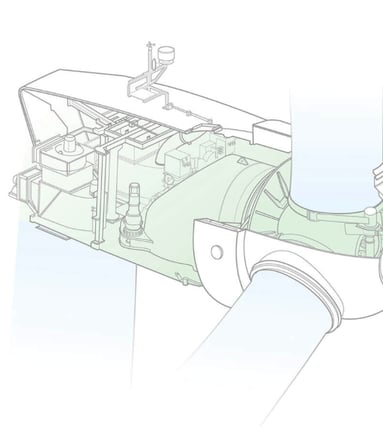The development of offshore wind turbine size has been astonishing over the last two decades. The size increase of the turbines has been so great that the rotor diameter has grown more than 6 times from the Vindeby offshore wind farm in 1991 comparing wind turbine types that will be constructed now more than 30 years later.
The future also points to an even further increase in rotor diameter as can be seen in the picture below that compares the commercially available wind turbines from SGRE to the EIA-15MW wind turbine NREL recently published.

Offshore wind turbine swept area comparison taken from app.youwindmodel.eu
But why is it important to increase the turbine size and thereby the swept area of the wind turbine and how does that influence the offshore wind farm economy?
Let’s start with the basics. The rated power output of offshore wind turbines is related to the swept area of the blades. The swept area is calculated with the following equation:
A = Π* (D/2)^² (m²)
Where A = turbine rotor swept area (m²) and D = Turbine rotor diameter (m).
The energy captured by the rotor is therefore a function of the area, and by doubling the rotor for instance, you double the amount of kinetic energy from the wind the turbine can capture.
Only by increasing the rotor diameter by 10 meters, the swept area increase is therefore almost 14% which enables a huge increase in the yearly energy yield.

HaliadeX offshore wind turbine with a 220m rotor.
If we now look at the difference between the SWT-7MW-154 turbine vs the SGRE-11.0-200DD turbine we can calculate that the swept area increase is from 18.600m² to 31.400m².
The rated output of the generator will also increase which is typically how much power the turbine can generate at a given wind speed (from 11-25 m/s). It is therefore important to analyze in detail the impact of the increased rotor diameter, rather than only the rated power of the wind turbine.
With bigger turbines and rated power, you can build the same wind power capacity but with fewer wind turbines which ultimately impacts the economy of the project. It is however important to stress the importance of the overall wind farm-swept area. This is despite the development of bigger turbines and therefore analyzing all types of commercially available wind turbines for your wind power project installation schedule is important to make from early-stage projects.
That is one of the reasons the YOUWINd model enables an easy comparison of wind turbine types for any project that you can try out at app.youwindmodel.eu. To read more about offshore wind power you can also log on and see our offshore wind farm guide.



